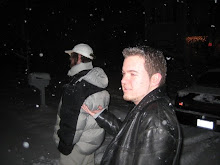Since I finished Blankets ahead of schedule and no new readings were assigned, I suppose I'll talk about the McCloud chapters that we read this week. I have to admit that I was disappointed when I found out that the subject of Chapter 3, "Blood in the Gutter", was not actually comic book violence. The brief depiction of the ax murderer slightly raised my hopes, but in vain. Oh well. The chapter was still fairly interesting, regardless. Creative use of the "gutter", or space in between panels, is an idea that had not occurred to me before reading this chapter. I'm used to reading the comics in the newspaper, where all of the different strips have so much allotted space and in large part just use three identically sized and equally spaced boxes to convey the action. However, in a larger magazine, or especially in a graphic novel such as Blankets, the artist has much more freedom with the layout of the pages and can do creative things with the panel size and shape.
I also found the bit about the different types of transitions to be interesting, if a little dry and scientific for the comic book medium. Some of the distinctions between the different transitions still seem a little arbitrary to me, but I think that McCloud does a good job of making something out of nothing with his research. The bar graphs make his points seem more credible because he can back up his claims with numbers and data. I wonder, though, if some of the claims made regarding the influence of Eastern art on Western art and vice versa are a bit outdated by now. It would be interesting to see now whether American graphic novels have taken more visual cues from Japanese manga, etc...
Chapter four does a good job of presenting and analyzing the challenges facing both the artist and the reader when attempting to convey time in comics. The passage of time in even the simple of scenes in comics is at best an estimation and at worst completely ambiguous. McCloud also makes a good point about the sequencing of panels. Sometimes I'm not sure which panel I'm supposed to look at next. There is no one perfect order that all artists and audiences are supposed to follow, as evidenced by the fact that most western comics tend to read left-to-right while their Japanese counterparts read right-to-left. Finally, I liked how McCloud broke down the various ways that artists have used to represent motion in comics over the years. Little motion blur lines are seldom thought of as distinctive elements of an artist's visual style, but McCloud proves that there is no simple way to show motion in a comic, giving rise to a variety of methods and styles that attempt to animate in an otherwise static medium.
In other news, I have added a list of links to the blogs of other members of the class, a blog roll, if you will. I cannot guarantee that every title is accurate or that every link works--these things have a habit of changing without notice and as I had to manually input the titles and links myself (is there a more automatic way?), they may be subject to human error. Nor can I guarantee that every person's blog is listed there. I counted, and I think I may have left a few out. If I neglected to list someone's blog it's either because I accidentally passed them over, or because I secretly hate them. Either way, really. I've also taken the liberty of sprucing the place up a bit, filling out juicy details in my profile and putting up a picture. Maybe someday soon I will work up the courage to venture forth and post comments on other people's blogs. Perhaps they will even reciprocate. For now I remain secure in the knowledge that the picture posted below is hilarious. If you fail to see the genius of these pictures, make sure that you actually click on them, as many of them will be animated. If they still fail to amuse you, then it's because you have no sense of humor.


No comments:
Post a Comment